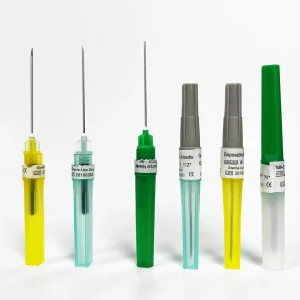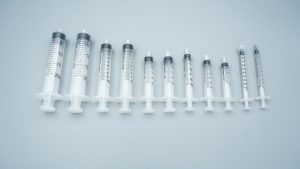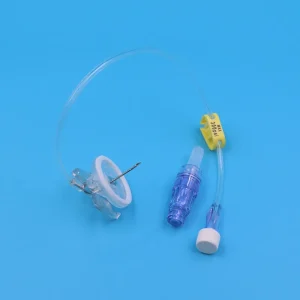In both medical and veterinary fields, syringes serve as indispensable tools. However, many people don’t fully understand the distinctions between human syringes and animal syringes. This article provides an in-depth professional analysis of these two categories, offering clear and accurate insights for both healthcare professionals and general readers.
Core Design Philosophy Differences
Precision-Oriented Human Syringes
The design of human syringes centers on precision and patient comfort. Since human patients can typically cooperate with treatment and communicate their feelings, human syringes prioritize pain reduction and injection accuracy. For instance, insulin syringes feature needle diameters of just 0.23-0.33mm, significantly reducing discomfort during injection.
Practicality-Focused Animal Syringes
In contrast, animal syringes emphasize practicality and safety. Because animals cannot cooperate like humans during treatment, animal syringes typically feature sturdier needles and larger-capacity barrels. Cattle syringes, for example, use needle diameters ranging from 0.8-1.2mm, enabling rapid delivery of large-volume vaccines or medications.
Material and Manufacturing Distinctions
Material Selection Considerations
Human syringes predominantly use medical-grade polymers such as polypropylene or polystyrene, materials known for excellent biocompatibility. Needles typically utilize 316L stainless steel with special silicone coating to reduce friction resistance.
Animal syringes prioritize durability and cost-effectiveness in material selection. Since animal skin is generally thicker than human skin, animal syringes employ more robust stainless steel alloys that can withstand greater penetration forces without bending or breaking.
Manufacturing Process Differences
Human medical syringes undergo stricter manufacturing processes, requiring FDA (Food and Drug Administration) or CE (Conformité Européenne) certification. Each syringe undergoes rigorous sterile processing and quality testing.
While animal syringes also maintain quality standards, their manufacturing focuses more on functionality and economic efficiency, typically costing 20-30% less than human syringes.
Differentiated Specifications and Capacity Design
Human Syringe Age-Group Classifications
Human syringes feature precise specifications tailored to different age groups:
Neonatal and Infant Syringes (0-2 years):
- Capacity: 0.5ml-1ml
- Needles: 25-27 gauge (0.4-0.5mm diameter), 6-13mm length
- Special design: Ultra-fine needles reduce pain and prevent deep tissue damage
Pediatric Syringes (3-12 years):
- Capacity: 1ml-5ml
- Needles: 23-25 gauge (0.5-0.6mm diameter), 13-25mm length
- Cartoon designs help alleviate children’s anxiety
Adult Syringes (18+ years):
- Capacity: 1ml-50ml
- Needles: 18-25 gauge (0.5-1.2mm diameter), 25-38mm length
- Specifications vary by injection site (intramuscular, intravenous, subcutaneous)
Geriatric Syringes (65+ years):
- Special grip design for easy handling
- Large-scale markings for vision-impaired elderly patients
Animal Syringe Species Classifications
Animal syringes feature specialized designs for different species:
Small Pet Syringes (cats, small dogs, rabbits):
- Capacity: 0.5ml-5ml
- Needles: 22-25 gauge (0.5-0.7mm diameter), 13-25mm length
- Features: Lightweight and agile for quick injections
Medium to Large Pet Syringes (large dogs, pigs):
- Capacity: 5ml-20ml
- Needles: 18-22 gauge (0.7-1.0mm diameter), 25-38mm length
- Bite-resistant design with extended handles for operator safety
Zoo Large Animal Syringes (lions, tigers, elephants, giraffes):
- Capacity: 20ml-100ml
- Needles: 14-18 gauge (1.2-2.1mm diameter), 50-100mm length
- Remote injection capability, such as dart syringe systems
- Anesthetic-specific features with specialized drug delivery mechanisms
Marine Animal Syringes (dolphins, whales, sea lions):
- Capacity: 10ml-200ml
- Waterproof sealed design for underwater use
- Curved needles adapted to marine animal body shapes
- Buoyant materials prevent accidental sinking
Livestock Syringes (cattle, horses, sheep):
- Capacity: 50ml-200ml
- Automatic continuous injection for multiple animals
- Needles: 12-16 gauge (1.4-2.1mm diameter), 38-75mm length
Professional Needle Specifications
Needle length and diameter serve as key distinguishing factors between human syringes and animal syringes. Human syringe needles typically range from 6-38mm in length, while animal syringe needles can exceed 100mm to accommodate varying animal skin thickness and muscle depth.
For example, elephant skin can be up to 2.5cm thick, requiring zoo animal syringes with specialized needles of at least 50mm length to effectively reach injection sites.
Special Application Scenarios: In-Depth Analysis
Unique Challenges in Marine Animal Medicine
Marine animal syringes represent the pinnacle of animal syringe technology innovation:
Underwater Operation Syringes:
- Waterproof rating meets IPX8 standards
- Special pressure-balancing design for underwater environments
- Needles use special alloys resistant to seawater corrosion
- Capacity range: 20ml-500ml for large marine mammals
Dolphin-Specific Syringes:
- Curved needle design accommodating streamlined dolphin bodies
- Rapid injection mechanisms minimize animal stress responses
- Eco-friendly materials prevent marine environment contamination
Special Requirements for Zoo Large Animals
Zoo syringes must handle extreme operating conditions:
Elephant-Specific Syringes:
- Ultra-long needles (75-100mm) penetrating 25mm-thick skin
- Large-capacity design (100-300ml) for 6-ton animal medication needs
- Pneumatic assistance systems reducing operator physical strain
Predator Syringes (lions, tigers, bears):
- Remote injection design with 10-15 meter safe distances
- Rapid anesthetic release mechanisms
- Automatic needle retrieval preventing accidental ingestion
Giraffe Syringes:
- Ultra-long operation poles (3-5 meters)
- Precision targeting systems
- Specialized needle angles for neck muscle anatomy
Cross-Considerations of Age Groups and Species
Interestingly, the age-segmentation principles of human syringes also apply to animal syringes:
Juvenile Animal Syringes:
- Newborn calves and foals use syringes similar to pediatric human syringes
- Needle specifications: 23-25 gauge, 15-25mm length
- Capacity: 2ml-10ml
Elderly Animal Syringes:
- Accounting for decreased skin elasticity in aged animals, needles feature sharper designs
- More precise injection speed control prevents tissue damage
Innovative Safety Mechanisms
Age-Specific Human Syringe Safety Features
Infant Safety Mechanisms:
- Ultra-short needle design prevents accidental deep penetration
- Color-coded safety caps for easy identification and management
- Anti-aspiration design prevents medication backflow
Adult Syringe Safety Features:
- Safety needle covers preventing accidental needlestick injuries
- Self-destructing design automatically disabling after single use
- Anti-reflux valves preventing blood backflow and infection
Senior-Friendly Design:
- Large-scale markings for vision-impaired elderly patients
- Non-slip grips accommodating hand tremors or reduced strength
Practical Animal Syringe Safety Design
Animal syringe safety design emphasizes operational convenience:
- Non-slip handles maintaining stable grip even during animal struggles
- Reinforced needle connections preventing detachment during injection
- Large-capacity reservoir design reducing frequent syringe changes
Regulatory Standards and Quality Control
Stringent Human Medical Device Standards
Human syringes must comply with extremely strict medical device standards, including:
- ISO 13485 Medical Device Quality Management System
- USP (United States Pharmacopeia) plastic product standards
- Rigorous biocompatibility testing
Specialized Veterinary Device Standards
Animal syringes follow dedicated veterinary device standards:
- ISO 14155 Veterinary Device Clinical Trial Standards
- VICH (International Cooperation on Harmonization of Technical Requirements for Registration of Veterinary Medicinal Products) guidelines
- Species-specific testing requirements for different animals
Surprising Commonalities
Despite numerous differences, human syringes and animal syringes share many important similarities:
Identical Basic Operating Principles
Whether human syringes or animal syringes, both operate on the same fluid dynamics principles. Through piston push-pull movements, pressure differentials are created within the syringe barrel, enabling medication aspiration and injection. This fundamental principle has remained unchanged since its 19th-century invention.
Equally Stringent Sterility Requirements
Both syringe categories must meet strict sterility requirements. Animal syringes and human syringes undergo gamma radiation sterilization or ethylene oxide sterilization before packaging, ensuring microbial load control within acceptable limits.
Single-Use Principle
Modern medical practice strictly adheres to single-use principles for both human syringes and animal syringes, effectively preventing cross-infection and disease transmission.
Cross-Species Design Commonalities
Common Features Across Human Age Groups:
- All use transparent or translucent barrels for medication and air bubble observation
- Clear scale markings ensure dosage accuracy
- Needle-to-barrel connections use standard Luer fittings
- All include protective caps for needle safety
Common Features Across Animal Species:
- Robust, durable design withstanding animal struggles
- Handle sections typically feature anti-slip textures or rubber materials
- Reinforced needle connections preventing detachment
- Prominent capacity markings for quick reading
Universal Commonalities Between Human and Animal Syringes:
- Both follow strict quality control standards
- Materials must pass biocompatibility testing
- Packaging uses sterile sealing methods
- Both feature clear expiration date labeling
- All needles undergo silicone treatment reducing injection resistance
Pharmacological Application Similarities
Interestingly, many human syringes and animal syringes share similarities in certain pharmacological applications. For example, certain vaccines (like rabies vaccines) are used for both humans and animals. While different syringe specifications are used, the basic drug delivery requirements remain consistent.
Professional Selection Guidelines
Strict Usage Scenario Differentiation
Healthcare professionals must strictly differentiate between human syringe and animal syringe usage scenarios. Animal syringes should never be used for human patients, as this violates medical ethics and poses potential safety risks.
Selection Guidelines for Different Professional Groups
Pediatric Healthcare Workers should choose:
- Ultra-fine needle human syringes (27-30 gauge needles)
- Cartoon-designed or colorful syringe housings
- Smaller capacity specifications to avoid medication waste
Veterinary Professionals should select based on animal type:
- Small Animal Veterinarians: Prefer 22-25 gauge animal syringes
- Large Animal Veterinarians: Use 14-18 gauge thick-needle, high-capacity animal syringes
- Wildlife Specialists: Equip with remote injection specialized animal syringes
- Marine Biology Veterinarians: Choose waterproof sealed specialized animal syringes
Cost-Effectiveness Balance Considerations
When selecting syringes, medical institutions must balance quality, safety, and cost. While human syringes cost more, their precision and safety ensure treatment effectiveness. Animal syringes offer better cost-effectiveness in veterinary practice.
Cross-Field Usage Precautions
Notably, in certain special circumstances, large-capacity human syringes that have undergone strict sterilization and safety assessment might be used for large animal emergency treatment, but this requires professional veterinary judgment and supervision. Conversely, animal syringes should never be used in human medicine.
Future Technology Trends
Smart Development Direction
Future human syringes and animal syringes are both evolving toward intelligent systems:
- Electronic dosage control systems
- Automatic injection depth adjustment
- Real-time injection parameter monitoring
Material Technology Advances
New material technologies are driving mutual progress in both syringe categories:
- Biodegradable material applications
- Superhydrophobic surface treatment technology
- Nanocoating technology enhancing sliding performance
Conclusion
While human syringes and animal syringes operate on identical principles, they exhibit significant differences in design philosophy, material selection, and specification standards. These differences reflect the unique requirements of different application scenarios. Understanding these similarities and differences is crucial for healthcare professionals’ correct selection and usage, while also helping the general public better appreciate the professionalism behind these everyday medical tools.
As medical technology continues advancing, both human syringes and animal syringes will continue evolving, but their respective professional positioning and core differences will persist. Proper understanding and usage of these tools forms the essential foundation for ensuring medical safety and treatment effectiveness.
Kohope is a professional manufacturer specializing in various types of syringes, offering customization and wholesale services.





